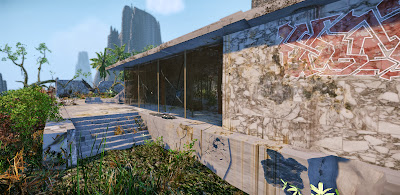https://www.dropbox.com/s/1i2xr57jj4fu087/BENV2423_balexiou_theisland_V03.cry
https://www.dropbox.com/s/mnmeqmlxv19h68s/BENV2423_balexiou_theisland.rar
Byron Alexiou BENV 2423
Monday, 18 November 2013
Reflection on week 12 lecture
The visiting lecturer, Jeremy Harkins, talked to us about real-time environments and real-time data and how this is used in modern day projects to give the user a simulated experience of a building environment. He talked about the current project at Barangaroo and how using real-time data his company were able to integrate all models of the proposed building into one real-time environment.
Strategy for demonstrating state of decay
The strategy I have followed to depict decay and structural failure in my building (Barcelona Pavilion) is that of human abandonment due to a plague which wiped out most of human life. Vegetation however continues to grow causing significant structural damage such as cracking, movement and direct damage from large trees falling onto walls and roofs. Glass has a long lifespan but is subject to breaking and cracking under structural pressure and extreme weather conditions. The roof of my building will also crack, leak and break into pieces exposing the understructure to further damage. Dirt, weathering and plant infestation will change the physical appearance of the materials making the building almost unrecognisable as compared to its original maintained state.
Reflection on week 11 lecture
In this lecture we were introduced to further techniques such as blend layers to add realistic detail to our decaying buildings. An interesting fact which Russell mentioned was that moss in the southern hemisphere only grows on the southern sides of buildings and the reverse in the northern hemisphere.
Subscribe to:
Comments (Atom)










